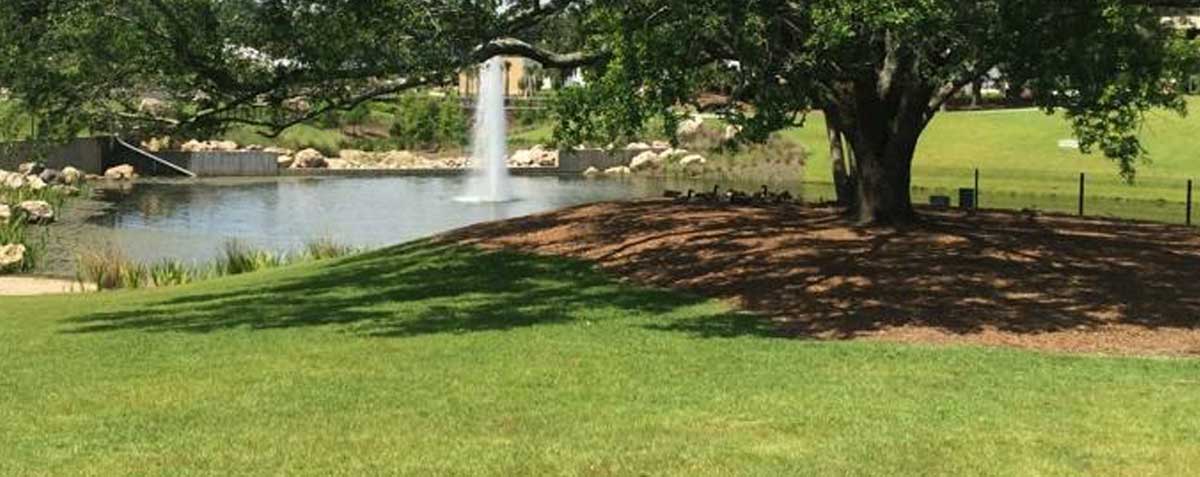Efforts to Address PFOA and PFOS in the Environment at Saufley Field
Saufley Field is associated with main base Naval Air Station (NAS) Pensacola and is located at:
6490 Saufley Field Road
Pensacola, FL 32509
Background
Perfluoroalkyl substances (PFAS) have been used in a variety of military applications. They have been used in relatively large quantities as components in aqueous film-forming foam (AFFF), which was routinely used at various military installations for fire-fighting training exercises, including at Saufley Field and NAS Pensacola. Current and historical AFFF storage and transfer areas are of potential concern for release to the environment. PFAS released into the environment may create potential concerns for human health and the environment because of their persistence, mobility, and possible toxicity. Of the thousands of compounds that are listed as PFAS, the EPA has established a lifetime health advisory (LHA) for two, perflourooctanoic acid (PFOA) and perfluoroctane sulfonate (PFOS), combined, of 70 parts per trillion (ppt), for drinking water. PFOA and PFOS are components of AFFF.
Saufley Field was commissioned as a Naval Auxiliary Air Station in 1940. In 1968, it was re-designated as a Naval Air Station and operated as such until 1976 when it was decommissioned and designated as an outlying landing field. In 1979, it was reactivated as a Naval Education and Training Program Development Center and as an outlying landing field for NAS Whiting Field pilot training. Its current mission is to support training and serve as home for several Department of Defense and other U.S. Government Organizations as a joint use facility. As part of historical facility operations, potential sources of PFAS at Saufley Field were related to the use, storage, and disposal of AFFF.
Per Navy policy, Areas of Concern (AOCs) with known, or potential, PFAS releases were identified and groundwater was sampled and analyzed for PFAS at those areas. For NAS Pensacola and Saufley Field, the AOCs most likely to have demonstrable PFAS contamination were the firefighter training areas where AFFF was used in training. PFOA and PFOS were determined to be present above their LHA in groundwater samples at both fire fighter training areas. NAS Pensacola is supplied water from nearby Navy Corry Station, which has been tested and is below the EPA LHA. Saufley Field is supplied water by ECUA. Due to the concerns for off-base drinking water impacts, the Navy tested nearby private wells that are downgradient of known or potential PFAS sources at both sites. From February through April 2019, the Navy tested private wells and held several Open Houses to share information on PFAS, encourage residents to sign up for well sampling, and to share the laboratory results of sampled wells. The Navy subsequently identified private drinking water wells within one mile of known and suspected PFAS source areas and arranged to have the private wells tested. Of the 50 private drinking water wells sampled around Saufley Field, 13 private wells exceeded the 70 ppt EPA LHA Level. Of the 9 private drinking water wells sampled downgradient of suspected source areas at NAS Pensacola, none exceeded the EPA LHA Level.
Current Status and Next Steps
The Navy has provided bottled water to the 13 residents whose private wells exceeded 70 ppt and will continue to do so until a long-term solution is implemented. The selected long-term solution is installation of a water main extension and hookup to each private home. The Navy worked with Emerald Coast Utility Authority to place the majority of the private homes on city water in early 2020 and is working to hook up the remaining homes sometime later in 2021. The remaining homes are receiving bottled water from the Navy and have had filter systems installed on their wells provided by the Department's Division of Water Restoration Assistance, Water Supply Restoration Program.
The Navy finalized the Preliminary Assessment in early 2021, identifying eight areas recommended for further PFAS evaluation. Field work to investigate those areas is expected to commence in the summer of 2021.
Correspondence Regarding PFAS Impacts
The Florida Department of Environmental Protection remains committed to the protection of groundwater resources of the state and the public health and safety of our residents.
Return to PFAS Investigation at Federal Facilities


